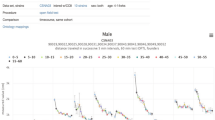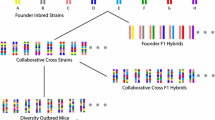Abstract
Whole-genome genetic association studies in outbred mouse populations represent a novel approach to identifying the molecular basis of naturally occurring genetic variants, the major source of quantitative variation between inbred strains of mice. Measuring multiple phenotypes in parallel on each mouse would make the approach cost effective, but protocols for phenotyping on a large enough scale have not been developed. In this article we describe the development and deployment of a protocol to collect measures on three models of human disease (anxiety, type II diabetes, and asthma) as well as measures of mouse blood biochemistry, immunology, and hematology. We report that the protocol delivers highly significant differences among the eight inbred strains (A/J, AKR/J, BALBc/J, CBA/J, C3H/HeJ, C57BL/6 J, DBA/2 J, and LP/J), the progenitors of a genetically heterogeneous stock (HS) of mice. We report the successful collection of multiple phenotypes from 2000 outbred HS animals. The phenotypes measured in the protocol form the basis of a large-scale investigation into the genetic basis of complex traits in mice designed to examine interactions between genes and between genes and environment, as well as the main effects of genetic variants on phenotypes.





Similar content being viewed by others
References
Ammassari-Teule M, Passino E, Restivo L, de Marsanich B (2000) Fear conditioning in C57/BL/6 and DBA/2 mice: variability in nucleus accumbens function according to the strain predisposition to show contextual- or cue-based responding. Eur J Neurosci 12: 4467–4474
Brown SD, Hardisty RE (2003) Mutagenesis strategies for identifying novel loci associated with disease phenotypes. Semin Cell Dev Biol 14: 19–24
Clark LD, Clark RK, Heber–Katz E (1998) A new murine model for mammalian wound repair and regeneration. Clin Immunol Immunopathol 88: 35–45
Crabbe JC, Wahlsten D, Dudek BC (1999) Genetics of mouse behavior: interactions with laboratory environment. Science 284: 1670–1672
Crawley JN, Belknap JK, Collins A, Crabbe JC, Frankel W, et al. (1997) Behavioral phenotypes of inbred mouse strains: implications and recommendations for molecular studies. Psychopharmacology (Berl) 132: 107–124
Davis M, Whalen PJ (2001) The amygdala: vigilance and emotion. Mol Psychiatry 6: 13–34
Davis M, Falls WA, Campeau S, Kim M (1993) Fear-potentiated startle: a neural and pharmacological analysis. Behav Brain Res 58: 175–198
Deacon RM, Rawlins JN (2005) Hippocampal lesions, species-typical behaviours and anxiety in mice. Behav Brain Res 156: 241–249
Demarest K, Koyner J, McCaughran J Jr, Cipp L, Hitzemann R (2001) Further characterization and high-resolution mapping of quantitative trait loci for ethanol-induced locomotor activity. Behav Genet 31: 79–91
Eum SY, Haile S, Lefort J, Huerre M, Vargaftig BB (1995) Eosinophil recruitment into the respiratory epithelium following antigenic challenge in hyper-IgE mice is accompanied by interleukin 5-dependent bronchial hyperresponsiveness. Proc Natl Acad Sci U S A 92: 12290–12294
Ewart SL, Kuperman D, Schadt E, Tankersley C, Grupe A, et al. (2000) Quantitative trait loci controlling allergen-induced airway hyperresponsiveness in inbred mice. Am J Respir Cell Mol Biol 23: 537–545
Falls WA, Carlson S, Turner JG, Willott JF (1997) Fear-potentiated startle in two strains of inbred mice. Behav Neurosci 111: 855–861
Flint J, Valdar W, Shifman S, Mott R (2005) Strategies for mapping and cloning quantitative trait genes in rodents. Nat Rev Genet 6: 271–286
Goren HJ, Kulkarni RN, Kahn CR (2004) Glucose homeostasis and tissue transcript content of insulin signaling intermediates in four inbred strains of mice: C57BL/6, C57BLKS/6, DBA/2, and 129X1. Endocrinology 145: 3307–3323
Green EC, Gkoutos GV, Lad HV, Blake A, Weekes J, et al. (2005) EMPReSS: European mouse phenotyping resource for standardized screens. Bioinformatics 21: 2930–2931
Greenspan RJ (2004) E pluribus unum, ex uno plura: quantitative and single-gene perspectives on the study of behavior. Annu Rev Neurosci 27: 79–105
Grillon C, Ameli R, Woods SW, Merikangas K, Davis M (1991) Fear-potentiated startle in humans: effects of anticipatory anxiety on the acoustic blink reflex. Psychophysiology 28: 588–595
Grubb SC, Churchill GA, Bogue MA (2004) A collaborative database of inbred mouse strain characteristics. Bioinformatics 20: 2857–2859
Hamelmann E, Schwarze J, Takeda K, Oshiba A, Larsen GL, et al. (1997) Noninvasive measurement of airway responsiveness in allergic mice using barometric plethysmography. Am J Respir Crit Care Med 156: 766–775
Heldt S, Sundin V, Willott JF, Falls WA (2000) Posttraining lesions of the amygdala interfere with fear-potentiated startle to both visual and auditory conditioned stimuli in C57BL/6 J mice. Behav Neurosci 114: 749–759
Hough TA, Nolan PM, Tsipouri V, Toye AA, Gray IC, et al. (2002) Novel phenotypes identified by plasma biochemical screening in the mouse. Mamm Genome 13: 595–602
Konno S, Adachi M, Matsuura T, Sunouchi K, Hoshino H, et al. (1993) [Bronchial reactivity to methacholine and serotonin in six inbred mouse strains.] Arerugi 42: 42–47
Levitt RC, Mitzner W (1988) Expression of airway hyperreactivity to acetylcholine as a simple autosomal recessive trait in mice. FASEB J 2: 2605–2608
Longphre M, Kleeberger SR (1995) Susceptibility to platelet-activating factor-induced airway hyperreactivity and hyperpermeability: interstrain variation and genetic control. Am J Respir Cell Mol Biol 13: 586–594
McCaughran JA Jr, Bell J 3rd, Hitzemann RJ (2000) Fear-potentiated startle response in mice: genetic analysis of the C57BL/6 J and DBA/2 J intercross. Pharmacol Biochem Behav 65: 301–312
Mott R, Talbot CJ, Turri MG, Collins AC, Flint J (2000) A method for fine mapping quantitative trait loci in outbred animal stocks. Proc Natl Acad Sci U S A 97: 12649–12654
Paylor R, Tracy R, Wehner J, Rudy JW (1994) Dba/2 and C57bl/6 mice differ in contextual fear but not auditory fear conditioning. Behav Neurosci 108: 810–817
R Development Core Team (2004) A language and environment for statistical computing (Vienna: R Foundation for Statistical Computing)
Rogers DC, Fisher EM, Brown SD, Peters J, Hunter AJ, et al. (1997) Behavioral and functional analysis of mouse phenotype: SHIRPA, a proposed protocol for comprehensive phenotype assessment. Mamm Genome 8: 711–713
Rossmeisl M, Rim JS, Koza RA, Kozak LP (2003) Variation in type 2 diabetes-related traits in mouse strains susceptible to diet-induced obesity. Diabetes 52: 1958–1966
Stoll M, Cowley AW Jr, Tonellato PJ, Greene AS, Kaldunski ML, et al. (2001) A genomic-systems biology map for cardiovascular function. Science 294: 1723–1726
Talbot CJ, Nicod A, Cherny SS, Fulker DW, Collins AC, et al. (1999) High-resolution mapping of quantitative trait loci in outbred mice. Nat Genet 21: 305–308
The Eumorphia Consortium (2005) EMPReSS: standardized phenotypic screens for functional annotation of the mouse genome. Nat Genet 37: 1–2
Acknowledgments
This work was supported by the Wellcome Trust.
Author information
Authors and Affiliations
Corresponding author
Rights and permissions
About this article
Cite this article
Solberg, L.C., Valdar, W., Gauguier, D. et al. A protocol for high-throughput phenotyping, suitable for quantitative trait analysis in mice. Mamm Genome 17, 129–146 (2006). https://doi.org/10.1007/s00335-005-0112-1
Received:
Accepted:
Published:
Issue Date:
DOI: https://doi.org/10.1007/s00335-005-0112-1




